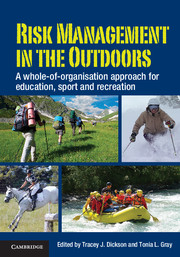 Risk Management in the Outdoors
Risk Management in the Outdoors Book contents
- Frontmatter
- Contents
- Tables
- Figures
- Contributors
- Preface
- 1 An introduction to risk, adventure and risk management
- 2 Organisational sustainability and risk management
- 3 The legal context for outdoor activities and programs
- 4 The organisational context of risk management
- 5 The real physical risks: putting it into perspective
- 6 Program design and activity selection
- 7 Program evaluation
- 8 Risk communication
- 9 Technology, risk and outdoor programming
- 10 Severe weather
- 11 Learning from injury surveillance and incident analysis
- Appendix Examples of risk analyses
- Index
Preface
Published online by Cambridge University Press: 05 June 2012
- Frontmatter
- Contents
- Tables
- Figures
- Contributors
- Preface
- 1 An introduction to risk, adventure and risk management
- 2 Organisational sustainability and risk management
- 3 The legal context for outdoor activities and programs
- 4 The organisational context of risk management
- 5 The real physical risks: putting it into perspective
- 6 Program design and activity selection
- 7 Program evaluation
- 8 Risk communication
- 9 Technology, risk and outdoor programming
- 10 Severe weather
- 11 Learning from injury surveillance and incident analysis
- Appendix Examples of risk analyses
- Index
Summary
To Risk
The person who risks nothing, does nothing, has nothing, is nothing.
He may avoid suffering and sorrow,
But he cannot learn, feel, change, grow or live.
Only a person who risks is free.
The pessimist complains about the wind;
The optimist expects it to change;
And the realist adjusts the sails.
William Arthur Ward
Undeniably, risk is part of the human experience. Risk management is a ubiquitous concern for those involved in outdoor education, sport and recreation as typically the focus has been on physical dangers. Varying degrees of danger exist within the myriad of activities undertaken in the outdoors, whether they are high physical risk activities such as rock fishing, equestrian sports or adventure racing or the more leisurely and low physical risk activities such as bird watching, dragon boat racing or simple bushwalking along a marked trail. Whatever the motivation, risk in its many forms and activities in the outdoors are inextricably linked.
There is universal acceptance that we engage in risk-taking behaviours as either an innate personal reward, or as a conquest or even as a badge of peer acceptance. Risk management in the outdoors covers the broad spectrum, from high to low risk activities. This book stems from over seventeen years of Australian industry interest in the management of risks in outdoor activities documented in the local literature on the subject, drawing upon a wide array of insights and experiences from industry experts.
- Type
- Chapter
- Information
- Risk Management in the OutdoorsA Whole-of-Organisation Approach for Education, Sport and Recreation, pp. xvii - xviiiPublisher: Cambridge University PressPrint publication year: 2011
